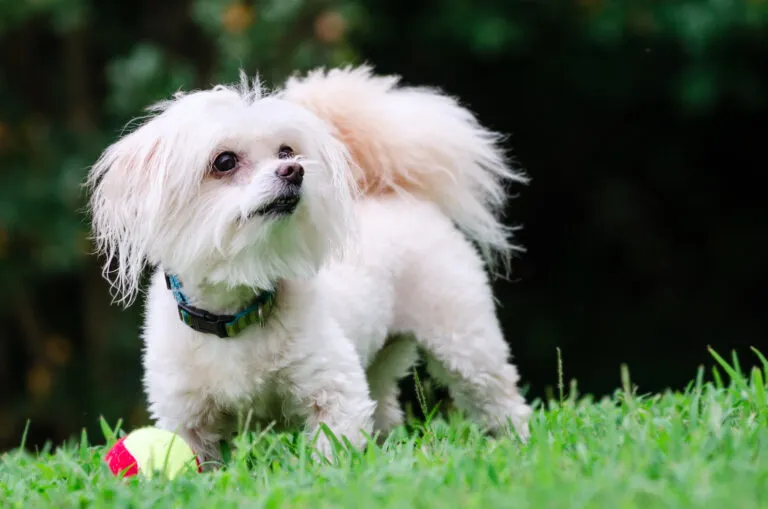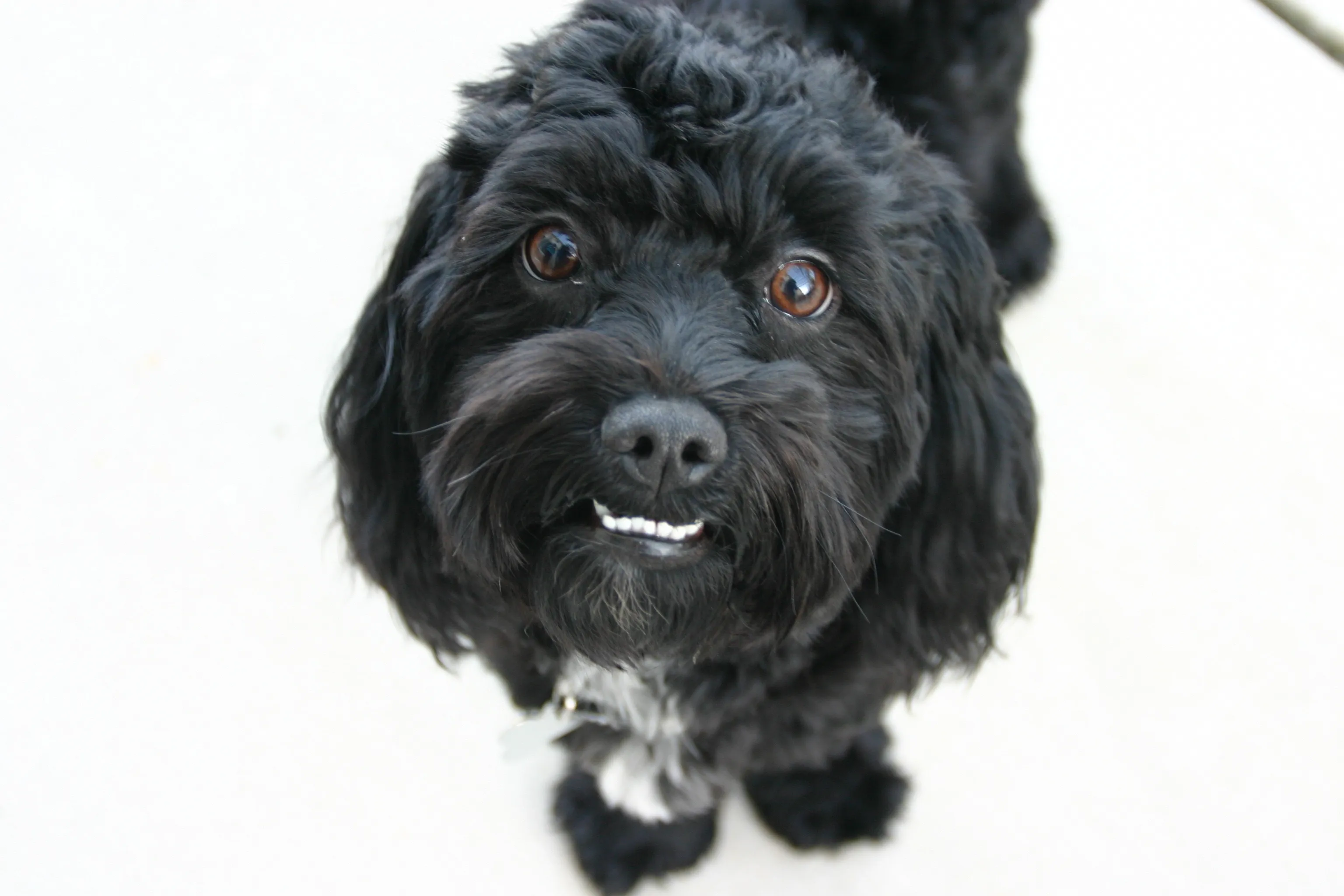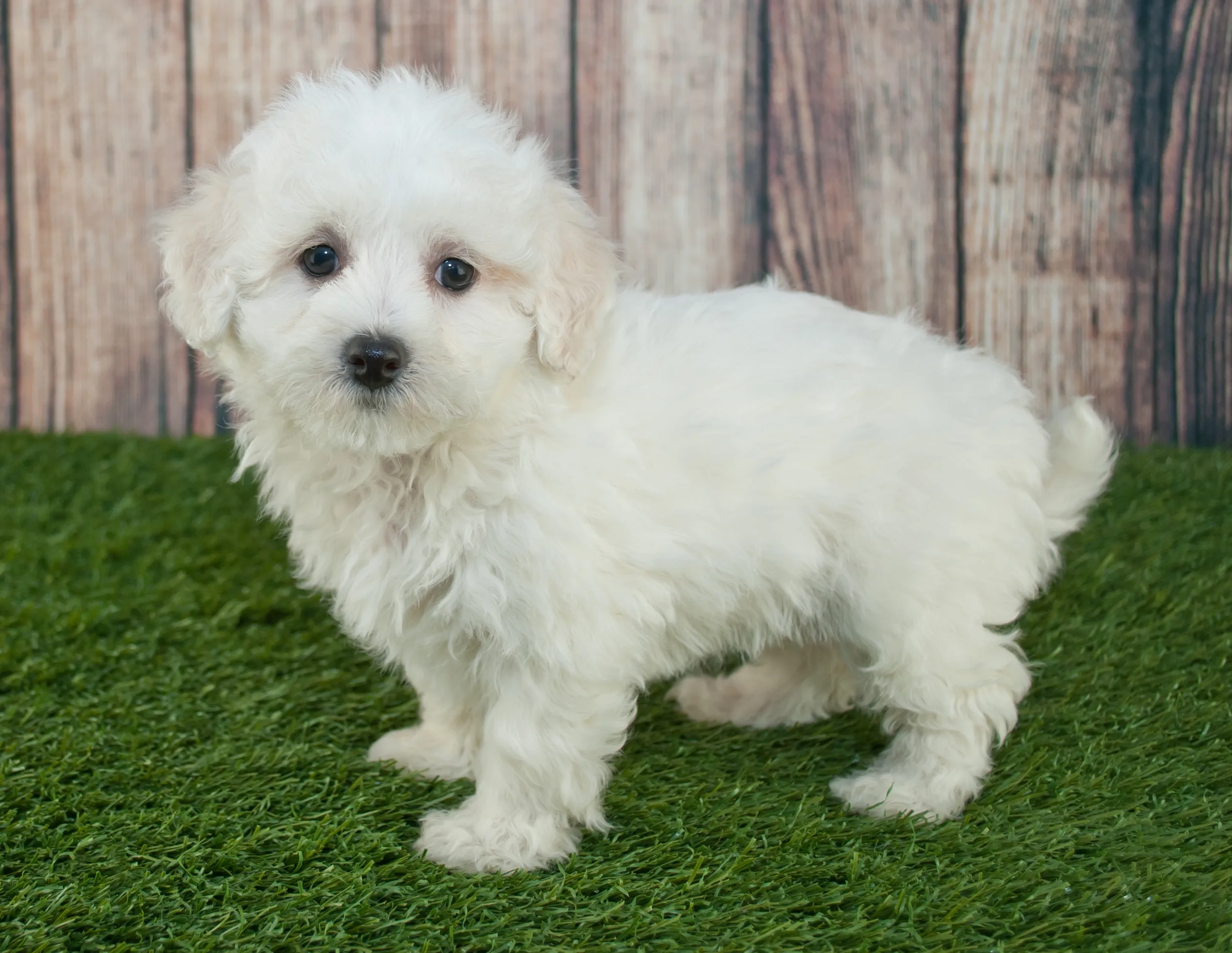Medium Size Poodle
The Goldendoodle, Cockapoo and Maltipoo all have something in common: They are hybrid dogs that resulted from pairing Poodles with one other established breed. These attractive designer dogs are currently quite popular, although dog lovers should confront the critical aspects of hybrid breeding before choosing one of these likeable canines.

© Robert Hainer / stock.adobe.com
Since Maltipoos are hybrids, their appearance cannot be generalised, i.e. there is no uniform standard. Regarding size, the Maltipoo is clearly a small dog. Depending on whether a Toy or Miniature Poodle was involved, they weigh between 2 and 10kg. On average they weigh around 4kg with a shoulder height of 28cm.
The lop ears and round eyes are also characteristic features that give the Maltipoo its typical teddy bear look. Although all Maltese dogs are white, Maltipoos can be found in all colours depending on the Poodle involved: They are found in white, black, brown, cream or apricot, whilst many are bicolour. The nose is usually black or pink.
The Maltipoo is a hybrid dog. There are always hybrids in small ads or online, where the benefits of combining the two breeds are advertised. This is nothing new, but designer dog fans usually go a step further. They advertise that only the positive traits of the two breeds can be found in the offspring – for instance, the non-moulting coat of a Poodle with the character of a Retriever.
The most famous designer dogs are probably the Labradoodle and Goldendoodle. The clever and robust Poodle is found strikingly often in hybrid breeds. Although Poodles are often discredited as a dog for grandmas, they have numerous positive character traits. In most cases, breeding does not continue with hybrids, because the inherited characteristics become more unpredictable in the second generation.
The Poodle is also used in the Maltipoo, which is a cross between a Maltese and a Toy or Miniature Poodle. The Maltese goes back to ancient lapdogs, whilst the Poodle’s ancestors were diverse utility dogs. As original hunting dogs, Poodles were mainly deployed for hunting in and around water, therefore have different character traits to a purely companion dog.
Due to their different ancestors, cute Maltipoos are a bag of surprises in terms of character. Nobody can predict which breed characteristics will be dominant. Maltipoos are often playful and form a close bond with their caregiver, who they like to follow everywhere. Both breeds are quite distanced towards strangers, therefore the Maltipoo usually is too.
They generally get on well with fellow dogs, but influences are key in this respect. The breeder should already socialise them extensively as puppies and prepare them for different situations from day-to-day life (hoovers, being touched, cats if necessary). Many Maltipoo owners describe their companions as curious, courageous and adventurous. They draw attention to unfamiliar things, although are not prone to yapping if they receive good training.
The same applies with training as with all other dogs: Don’t make any exceptions from the established rules. Even if your Maltipoo looks at you heartbreakingly, always be consistent in matters of training so that your companion knows from the start that it can count on you. All family members should work as one in this sense.
If you communicate clear rules to your new canine housemate, it will soon adhere to them. Even lightweight dogs can be very stressful if they haven’t learnt basic obedience. Attend puppy school with your dog and later training sessions at dog school to support its social behaviour and to learn together.
 © anissat / stock.adobe.com
© anissat / stock.adobe.com
Hybrid buyers often argue that they are in general healthier, since the gene pool is larger than with pedigree dogs.
With scrupulously selected pedigree dogs, however, the dogs have undergone numerous examinations before even being allowed to be deployed for breeding. This is because most associations require a suitability for breeding test before a dog may be deployed for breeding. Hence, you get a minimum level of security regarding the health of your future housemate when making your purchase. Committed breeders are willing to give you information about healthcare provision for their breed.
Unfortunately only a few hybrid breeders invest financially in extensive health check-ups before breeding deployment. Since many diseases only emerge in adult dogs, the buyer in question ends up paying later down the line. Parent animals should be examined for breed-specific diseases with a Poodle and Maltese cross. With both breeds, primarily ocular diseases as well as problems with the knee joints should be mentioned.
Appropriate exercise and a healthy body weight can protect your Maltipoo’s joints. The unusual combination of coarse Poodle and silky Maltese fur can also lead to skin problems in some cases. Otherwise, a healthy Maltipoo will reach an average age of 15 years.
What should end up in a Maltipoo’s food bowl? Like the Poodle, Maltese and all other dogs, these cute hybrids are better off eating a dog food with plenty of animal protein. Check on the packaging how much meat the respective dog food contains: Meat should always be at the top of the ingredients list. Fillers like grain or sugar should have no place in your dog’s food.
It is very much possible to combine wet and dry food: For instance, use dry food as reward snacks for training or during search games and provide wet food as the main meal. Whilst your puppy needs several meals per day, an adult dog copes with one or two.
Rawhide chew bones in a suitable size or dried chunks of meat offer your Maltipoo extra chewy pleasure. However, keep an eye on its waistline to avoid weight gain. Your companion should be able to quench its thirst at any time.
Tip: If you are going on a longer hike with your Maltipoo, take a portable water bottle with you.
Whilst the Poodle requires little grooming, the Maltese is quite high-maintenance in this respect. These little dogs with long white fur don’t just need brushing daily, but regular baths too.
The development of a hybrid dog’s coat cannot be predicted. As already described, the Maltese’s genetic disposition and the different fur texture of the Maltese and Poodle can lead to fur and skin problems.
Grooming can also prove demanding. Some Maltipoo owners describe the fur as difficult to comb and prone to becoming matted quickly. Hence, you should factor in time for grooming your Maltipoo every day. If it has longer fur, you should keep an eye out for little twigs or leaves after every walk and remove them. A dog groomer can advise on the coat, because shearing Maltipoos can often lead to skin and fur problems.
If your Maltipoo’s claws are too long, you should cut them with special claw clippers. Check the claws every few weeks. A clicking noise when it walks indicates that you should reach for the clippers. If you still haven’t practiced this, ask experienced dog owners or your vet for advice.
These little bundles of energy enjoy long walks that give them the chance to sniff around and let off steam. A trained adult Maltipoo will also happily accompany you on longer hikes. However, you should make sure not to over-challenge your four-legged friend.
Maltipoos are often playful, so you can make your companion truly happy with different toys for small dogs. Many enjoy learning tricks together with you or retrieval. Agility for small dogs is an opportunity to give your Maltipoo species-appropriate stimulation. Remember to deliberately encourage rest periods so that your Maltipoo learns to enjoy them too.
 © jstaley4011 / stock.adobe.com
© jstaley4011 / stock.adobe.com
A Maltipoo can be just as happy living in the countryside as in a city apartment. The main thing is that it may (almost) always be close to you! These friendly dogs are usually good for first-time owners. However, read up on dog training in detail and attend a dog school with your canine to get valuable tips for living together.
These friendly dogs can live well as part of a family. If your children are still very young, you should make sure that they don’t see the dog as a toy. There is the danger that they injure these delicate canines unintentionally. Hence, teach your children to treat animals with respect from an early age. As well, your Maltipoo should always have the possibility to retreat if the hustle and bustle becomes too overwhelming.
As it’s difficult to assess how high-maintenance a puppy will be in adult age, you should be willing to spend some time on grooming every day.
Before your dog enters your home, arrange who will take care of it if you are on holiday or sick. Due to its convenient size, you can take it with you depending on the holiday destination. More and more hotels or B&Bs are now welcoming four-legged guests too, as long as they are well-trained.
You should also estimate the costs that a Maltipoo will incur in the long term before it enters your home. Along with the purchase price (maltipoo with pedigree can cost from £450 to over £1000) and basic equipment, you will encounter ongoing expenses: a high-quality food, veterinary check-ups including vaccinations and deworming as well as potential appointments with the dog groomer or a budget for acute illnesses.
When looking for a puppy, it is recommended to seek out a breeder who is part of an FCI-recognised association and provides relevant paperwork. This is the only way you can be certain that the breeder adheres to the breed standards and statutes of the association in question.
However, you won’t find any breeders belonging to an association since the Maltipoo is not an independent breed. Be particularly sure to avoid breeders who advertise with false paperwork, because no association belonging to a reputable umbrella organisation will issue any paperwork for a breed that doesn’t exist. If it absolutely has to be a Maltipoo puppy, try to find out as much as possible about the parent animals involved and their origin.
Better yet, look directly at Poodle and Maltese breeders. Perhaps one of the two breeds is suitable for you? Both have wonderful character traits and there are plenty of responsible breeders to whom you can turn in search of your new housemate. Even attending a dog exhibition where you can admire different breeds in the flesh and come into contact with breeders can be helpful when it comes to finding the right breed.
If you’re looking for an adult dog, you’re better off looking in local animal shelters or online, where you will certainly find a suitable canine. There are numerous little hybrids in animal shelters just waiting for a new home. Upon the first encounter, you can already get an idea of the coat texture and behaviour of the dog. You won’t just find your dream dog, but will also be making a big contribution to animal welfare. Alternatively, you can search for adult Poodles or Maltese dogs, which are often looking for a new home through special breed associations.
Here are some purchase proposals curated by the zooplus editorial team
The products featured have been carefully selected by our editorial staff and are available at the zooplus online pet shop. The selection does not constitute advertising for the mentioned brands.
Fans of the Bearded Collie agree that those who aren't familiar with this dog breed simply have to get acquainted with it. And those who have experienced how a Bearded Collie bolts across meadows with its flowing fur, how it rolls around full of energy and joy and how it attentively and observantly takes into account its owners wishes become simply addicted to this original dog breed and its unique charm.
The Goldendoodle isn't a breed, but a pairing between Golden Retrievers and Medium or Standard Poodles. Marketed as a low-maintenance dog for allergy sufferers, this hybrid is enjoying increasing popularity amongst dog lovers, similar to the Labradoodle.